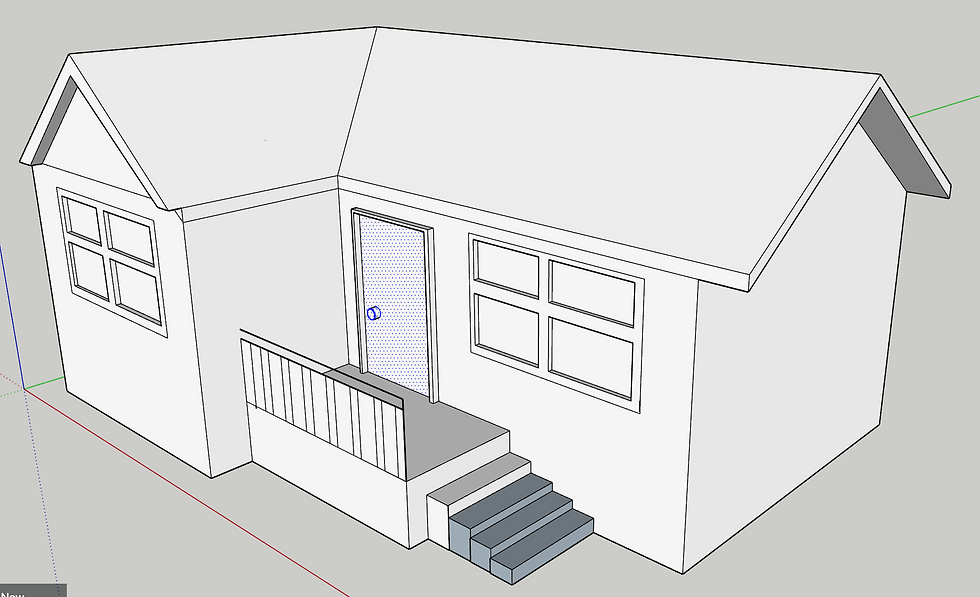Week 3 - Design Thinking
- Harry_
- Mar 18, 2023
- 2 min read
Updated: Apr 7, 2023
Design thinking is an iterative process, where the user, “creates, challenges idea and redefines problems in an attempt to develop alternative strategies and solutions that may not be instantly apparent” (Dam & Siang. 2021). In an educational context, students develop, assess, and redefine using design-based thinking in digital creativity.
Sketchup is an intuitive 2D and 3D modelling application that is used in many architectural and design-based professions. (Gavin, 2018). Sketchup can be implemented into the classroom to enhance student creativity as there are many elements of design thinking that it encompasses, including; Brainstorming, prototyping and testing.
Fostering Creativity:
SketchUp can be used to foster creativity through its easy cross-curriculum application. Subjects including Science, Geography, Mathematics and art can all include Sketchup as part of a lesson plan. A project by Galani (2015), displayed that SketchUp was used to “create awareness about spaces and their functions”. Specifically, students used sketch up in geography lessons to redesign spaces in the school digitally, ultimately connecting real spaces with technology which boosted visualisation and familiarity in the space.
Sketchup satisfies syllabus outcomes in many areas including stage 3 mathematics (MA3-3DS-01), where the identification and sketching of three-dimensional objects at different views is assessed, (NESA, 2023). Ultimately SketchUp allows students to enhance creativity, problem-solving, evaluation and generalisation skills
Pedagogical Critiques:

Sketchup is a software program meaning students must have access to a computer or tablet, which may be a challenge in a primary school setting. This can result in inequalities and imbalances in accessibility for students.
CC by Harrison Britton
Being able to Assess students' work in Sketchup presents a challenge. Being able to Evaluate the quality of open-ended design-based work takes skill as it does not encompass subjective criteria.

Navigating Sketchup provides a challenging Learning Curve for students. Students may take a long period of time before coming proficient in using the software. Therefore, SketchUp may be time-consuming for teachers when trying to foster creativity.
CC by Harrison Britton
Comparing Sketchup to similar tools for design-based thinking, Sketchup is more suitable for a classroom rather than other digital platforms such as Autocad and Rivet due to its cost-effectiveness and ability to foster creativity for younger students.
References:
Dam, R. F., & Siang, T. Y. (2021). What is design thinking and why is it so popular?
Galani, L. (2015). Redesign the school yard using Google SketchUp: a pilot project. Int. J. Res. Educ. Method, 7(2), 1101-1110.Gavin, B. (2018). What is Sketchup (and how do I use it)? HowToGeek
Galani, L. (2015). Redesign the school yard using Google SketchUp: a pilot project. Int. J. Res. Educ. Method, 7(2), 1101-1110.
NSW Education Standards Authority (NESA) (2023). Stage 3. Mathematics K-10. https://curriculum.nsw.edu.au/learning-areas/mathematics/mathematics-k-10-2022
Symetri UK (2017). Sketchup Video Overview. Youtube
Hi Harrison,
There was clearly a piece of technology that was identified here – SketchUp. Unfortunately, no comparisons were made to other similar pieces of technology and this impacts your context for this piece of technology. Fostering creativity could maybe be further explained, I feel as though you were linking the piece of technology to subjects this could be used in in education. However, your explanation of how SketchUp can be used in the classroom was done really well. Clear evidence of personal footage, well done for correctly labelling “CC by Harrison Britton”. Just remember to also give credit to YouTube for the YouTube video you incorporated at the beginning of the post. Limitations were clear and well thought out,…
Hi,
The blog is set up super nice with heaps of pictures and spilt up of paragraphs has made it easy to connect with your material. I would have liked a little more information regarding the limitations however your comparsion of other 3D software was useful.
Alicia xerri
01/4/23
Hi Harry!
You've done a really good job addressing various pros and cons to using Google SketchUp, especially in how you connected it's benefits to syllabus outcomes!
I also enjoyed your point about the cross-curricular applicability of the tool and it's exciting to think about the potential for fostering creativity in different educational contexts.
I would've enjoyed more elaboration on the potential deficits like how you mentioned access to computers in primary school settings creates inequalities. What inequalities? Inequalities in accessibility? Then in what way? Low SES? Just food for thought.
Regardless, very impressed with your blog post, keep it up, well done sir!
20/3/23
Your blog is incredibly well written, and clearly very well researched. SketchUp seems like a great tool to use in the classroom, and I loved your direct links to the syllabus outcomes showing exactly how the technology could be used in a mathematics context.
Your reflection on the limitations of the technology are also very apt, it it always important to note when students will not all have the same access or ability with a piece of technology.
Overall, your blog is easy to navigate, and shows a clear understanding of how important digital creativity is. You've engaged well with peers too, and shown good insight into their work as well.
Great blog, you should be proud!
19/03/2023
Hi there Harry I loved your use of SketchUp and your explanation of its usefulness in developing design technology skills! I am sure students will be actively engaged with this content, especially within the content area of the maths syllabus of manipulating 3D objects! I also appreciate your use of the limitations that can significantly impact SketchUp, as although it can be helpful to develop these skills for evaluating and redesigning images, it can be incredibly difficult or expensive for teachers to utilise on the school devices as well as teachers would need to learn how to use the technology themselves, which can become difficult. However, I would like to see more positive pedagogical aspects! I think this would work effectively with…